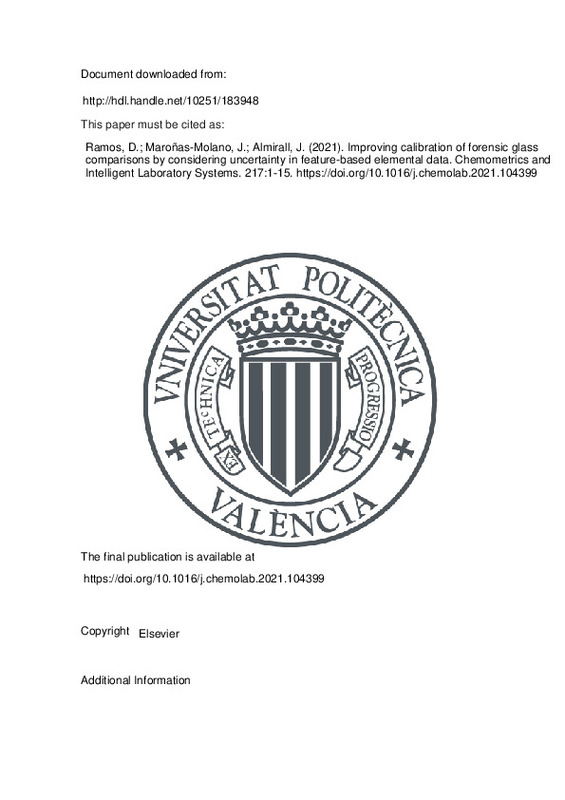JavaScript is disabled for your browser. Some features of this site may not work without it.
Buscar en RiuNet
Listar
Mi cuenta
Estadísticas
Ayuda RiuNet
Admin. UPV
Improving calibration of forensic glass comparisons by considering uncertainty in feature-based elemental data
Mostrar el registro sencillo del ítem
Ficheros en el ítem
| dc.contributor.author | Ramos, Daniel
|
es_ES |
| dc.contributor.author | Maroñas-Molano, Juan
|
es_ES |
| dc.contributor.author | Almirall, Jose
|
es_ES |
| dc.date.accessioned | 2022-07-07T18:03:55Z | |
| dc.date.available | 2022-07-07T18:03:55Z | |
| dc.date.issued | 2021-10-15 | es_ES |
| dc.identifier.issn | 0169-7439 | es_ES |
| dc.identifier.uri | http://hdl.handle.net/10251/183948 | |
| dc.description.abstract | [EN] The computation of likelihood ratios (LR) to measure the weight of forensic glass evidence with LA-ICP-MS data directly in the feature space without computing any kind of score as an intermediate step is a complex problem. A probabilistic two-level modeling of the within-source and between-source variability of the glass samples is needed in order to compare the elemental profiles measured from glass recovered from a suspect or a crime scene and compared to glass samples of a known source of origin. Calibration of the likelihood ratios generated using previously reported models is essential to the realistic reporting of the value of the glass evidence comparisons. We propose models that outperform previously proposed feature-based LR models, in particular by improving the calibration of the computed LRs. We assume that the within-source variability is heavy-tailed, in order to incorporate uncertainty when the available data is scarce, as it typically happens in forensic glass comparison. Moreover, we address the complexity of the between-source variability by the use of probabilistic machine learning algorithms, namely a variational autoencoder and a warped Gaussian mixture. Our results show that the overall performance of the likelihood ratios generated by our model is superior to classical approaches, and that this improvement is due to a dramatic improvement in the calibration despite some loss in discriminating power. Moreover, the robustness of the calibration of our proposal is remarkable | es_ES |
| dc.description.sponsorship | This work has been partially developed during a research stay of D. R. at the Machine Learning Group of the Department of Engineering, University of Cambridge, UK; funded by the Spanish Ministerio de Educacion, Cultura y Deporte under the program for mobility of professors and researchers in higher education and research centers. We strongly thank Dr. Jose Miguel Hernandez-Lobato for all the ideas and discussions about the algorithmic developments in this article, and for hosting the aforementioned research stay. We also thank Peter Weis and Sonja Menges from the German Federal Police (Bundeskriminalamt) for their support, their revision of the manuscript, and for providing the BKA database. This development of the Florida International University (FIU) background database of vehicle glass samples was supported by Award No. 2018-DU-BX-0194 from the National Institute of Justice, Office of Justice Programs, U.S. Department of Justice to Florida International University. The opinions, findings, and conclusions or recommendations expressed in this manuscript are those of the authors and do not necessarily reflect those of the National Institute of Justice or the U.S. Department of Justice. D. R and J. M. were supported by the Spanish Ministerio de Educaci ~on, Cultura y Deporte through grant RTI2018-098091-B-I00. J.M is also supported by grant FPI-UPV associated to the DeepHealthProject, grant agreement No 825111 | es_ES |
| dc.language | Inglés | es_ES |
| dc.publisher | Elsevier | es_ES |
| dc.relation.ispartof | Chemometrics and Intelligent Laboratory Systems | es_ES |
| dc.rights | Reconocimiento - No comercial - Sin obra derivada (by-nc-nd) | es_ES |
| dc.subject | Likelihood ratio | es_ES |
| dc.subject | Forensic glass comparison | es_ES |
| dc.subject | LA-ICP-MS | es_ES |
| dc.subject | Variational autoencoder | es_ES |
| dc.subject | Warped Gaussian mixture | es_ES |
| dc.subject | Heavy-tailed | es_ES |
| dc.subject.classification | CIENCIAS DE LA COMPUTACION E INTELIGENCIA ARTIFICIAL | es_ES |
| dc.title | Improving calibration of forensic glass comparisons by considering uncertainty in feature-based elemental data | es_ES |
| dc.type | Artículo | es_ES |
| dc.identifier.doi | 10.1016/j.chemolab.2021.104399 | es_ES |
| dc.relation.projectID | info:eu-repo/grantAgreement/AEI/Plan Estatal de Investigación Científica y Técnica y de Innovación 2017-2020/RTI2018-098091-B-I00/ES/APRENDIZAJE PROFUNDO EN VOZ PARA APLICACIONES FORENSES Y DE SEGURIDAD/ | es_ES |
| dc.relation.projectID | info:eu-repo/grantAgreement/NIJ//2018-DU-BX-0194/ | es_ES |
| dc.relation.projectID | info:eu-repo/grantAgreement/EC/H2020/825111/EU | es_ES |
| dc.rights.accessRights | Abierto | es_ES |
| dc.description.bibliographicCitation | Ramos, D.; Maroñas-Molano, J.; Almirall, J. (2021). Improving calibration of forensic glass comparisons by considering uncertainty in feature-based elemental data. Chemometrics and Intelligent Laboratory Systems. 217:1-15. https://doi.org/10.1016/j.chemolab.2021.104399 | es_ES |
| dc.description.accrualMethod | S | es_ES |
| dc.relation.publisherversion | https://doi.org/10.1016/j.chemolab.2021.104399 | es_ES |
| dc.description.upvformatpinicio | 1 | es_ES |
| dc.description.upvformatpfin | 15 | es_ES |
| dc.type.version | info:eu-repo/semantics/publishedVersion | es_ES |
| dc.description.volume | 217 | es_ES |
| dc.relation.pasarela | S\444659 | es_ES |
| dc.contributor.funder | European Commission | es_ES |
| dc.contributor.funder | National Institute of Justice | es_ES |
| dc.contributor.funder | Ministerio de Ciencia, Innovación y Universidades | es_ES |







![[Cerrado]](/themes/UPV/images/candado.png)

